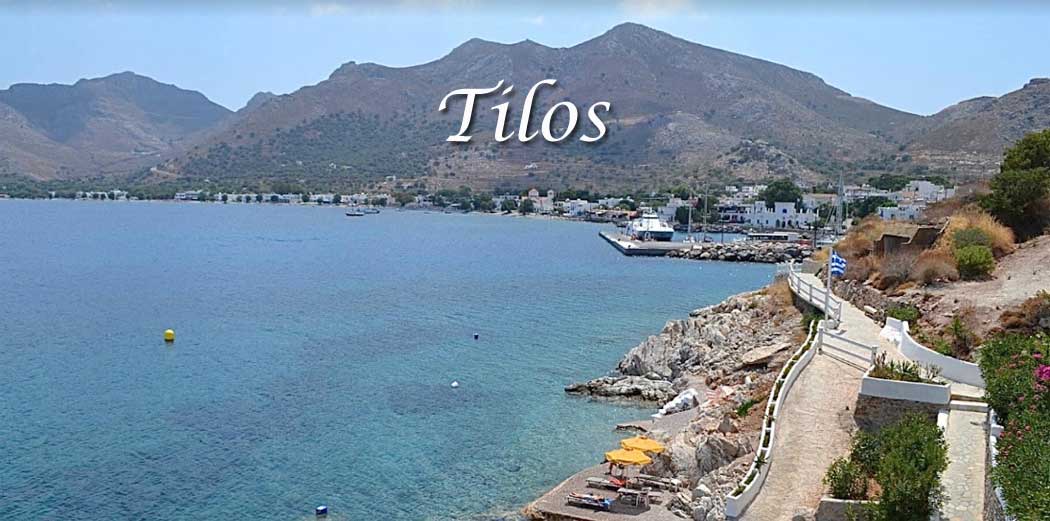Information about the island of Tilos Greece
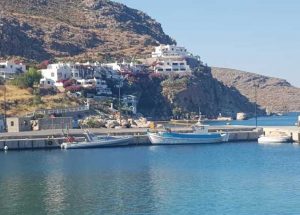
The locals live traditionally off fishing, some farming and stock-breeding, and to a certain extent tourism. Some speak English, others don’t but they are friendly and warm and like to make you feel welcome.
Tilos is one of the least visited and most unspoilt islands in the Dodecanese but has much to offer the discerning tourist who hankers after a taste of the “real Greece “. This is a walkers’ and bird watchers’ paradise. The island is a resting place for many different species of migratory birds and if you roam its hillsides you’ll find crusader castles, medieval monasteries and valleys awash with cypress, oak, walnut and almond trees. There are some lovely uncrowded beaches some of which have red lava sand – a legacy of the volcanic eruptions that have repeatedly reshaped the nearby island of Nisyros over the last 24,000 years.
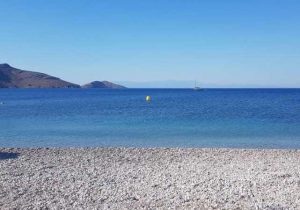
The island of Rhodes, which has an international airport several European destinations, is a more manageable one hour journey by hydrofoil. Tilos also has ferry, hydrofoil and catamaran links with several other Dodecanese islands including Nisyros, Kos and Symi.
If you arrive here from Rhodes you’ll find yourself a million miles away from the Dodecanese capital with its frantic seaside resort of Faliraki where drunken package holidaymakers party round-the-clock. This is a place to relax and unwind, while away the hours in a traditional taverna and explore the countryside of an island as yet unscathed by the ravages of mass tourism.
Take the time to delve into the island’s rich past because today’s sleepy Tilos is the product of a turbulent history. The seven small castles on the island were built as outposts of the Knights of St John who held sway here from 1309 until 1522 when Tilos fell to the Turks. The island was under Turkish domination until 1912 when it was ceded to the Italians. It was only in 1948 that the island finally became part of a united Greece.
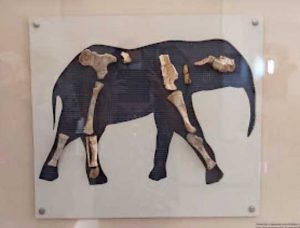
At Agios Antonios Beach to the west of Megalo Chorio you can see the petrified remains of human skeletons, thought to be those of sailors caught in the Nisyros eruption of 600 BC.
One of the island’s most famous daughters was the poet Erinna, a friend and contemporary of the better-known Greek poet Sappho. Erinna was born on the island in the 7th century BC – her work was widely regarded as being equal to that of Homer, one of the greatest writers of ancient Greece.
History of Tilos
Tilos was, according to mythology, the nephew of the men that educated god Zeus during his upbringing on Crete. He desperately sought for a cure for his sick mother, and after traveling widely, he finally found some herbs on this island that made his mother well. He then returned to the island and built temples to Apollo and Poseidon and became their priest.
There is archaeological evidence that the Minoans, Cretans, had a settlement on this island around 1500 BC. It was a member of the Athenian League in the 5th century BC, and was conquered by the Romans in the 1st century BC.
The Knights of Rhodes took over the island in 1306, and was occupied by the Turks in the 16th century. The locals would then live up in the mountains to protect themselves from pirates and enraged Turks, and did not move further down until the 19th century.
In 1912 the island belonged to Italy, and there were also German soldiers here during the last two years of World War II. It became part of Greece in 1948. Tilos became suddenly very popular in the summer of 2008 when the mayor of the island permitted the marriages of homosexuals in Tilos.
What to see
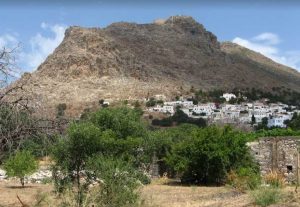
You can also visit the Castle of the Knights, where the Knights of St. John had a base in the 15th century. Built on ancient ruins at the top of the hill just above Megalo Chorio, it is accessible by footpath (twenty minute route) and offers a unique panoramic view of the valley and the beach Eristo and the fishing village of Agios Antonios.
There are many little churches on the island, and the church of the Archangel Michael is probably the best known. It is situated in Megalo Chorio. One of the main attractions of the island is the Park of Tilos with many areas of amazing flora and fauna. Another interesting place is the cave of Charkadio where the visitor can see remains from the dwarves Elephants that lived on the island 45000 years ago. The fossilized bones where first discovered in the 70’s. The dwarves Elephants disappeared from Tilos island 4000 years ago.
Palaeontological Museum
The town’s small Palaeontological Museum on the main street houses the fossilised bones of mastodons (midget elephants) dating back to 7,000 BC. The bones were found in the Harkadhio Cave in the centre of the island in 1971. A ruined fortress marks the location of the cave which is not open to visitors due to ongoing excavations. The museum is also home to a golden treasure trove found in a Hellenistic tomb on the island.
Charkadio Cave
It made Tilos famous to paleontologists, as dwarf elephant bones dating back 50,000 years were found here, as well as even earlier deer bones and Neolithic tools. It is not open to the public, but some exhibits are on display at the museum in Megalo Chorio.
The fossilized remains of a population of dwarf elephants that once lived on the Greek island of Tilos is a phenomenon where animals that originally lived on larger landmasses evolve to become smaller in size when they inhabit smaller islands with limited resources.
The dwarf elephants of Tilos are believed to belong to the species Elephas antiquus, which was a type of straight-tusked elephant that lived in Europe during the Pleistocene epoch. These elephants were significantly smaller than their mainland relatives. They stood only about 1.2 to 1.5 meters (4 to 5 feet) tall at the shoulder, making them roughly the size of a large modern-day calf.
Fossils of these dwarf elephants, including skeletal remains and teeth, have been found on the island. These discoveries provide valuable insights into the natural history and evolution of elephants. The presence of dwarf elephants on Tilos is of great significance to the study of paleontology and evolution
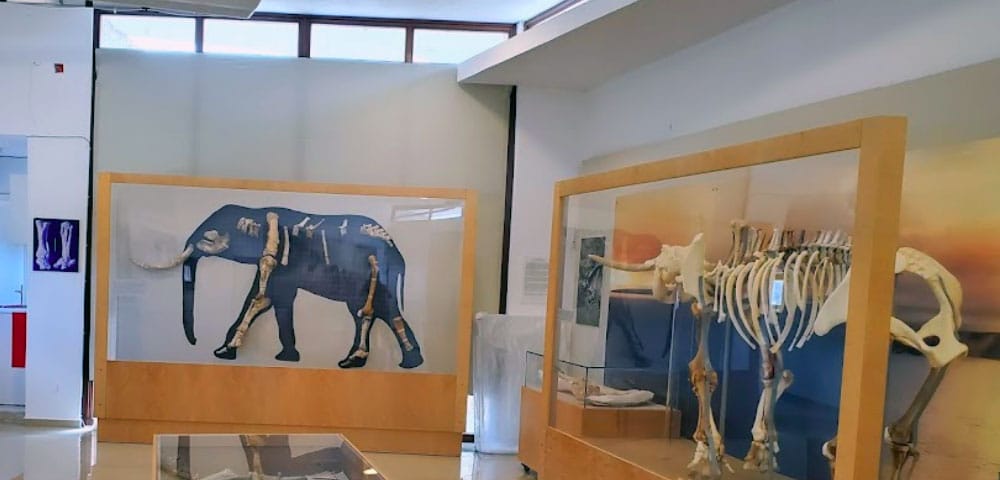
Agios Panteleimonas
Stone monastery in a ravine, with a unique view of the Aegean. It was built in 1470 and has pebble floors, old frescoes and courtyards where free animals move. He is the patron saint of the island and celebrates with a big festival.
Taxiarchis Church
The main church of Megalo Chorio, with western influences on the architecture and pebble floors. The silver icons come from the Taxiarchis of the Castle, while the colored wood-carved iconostasis was made by Smyrna craftsmen.
Where to swim
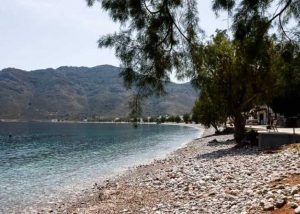
Wonderful waters, pebbles and tamarisks for camping in Plaka bay after Agios Antonios. Wonderful pebble beach with cool waters, Lethra is ideal for solitary dives.
They are accessible by footpath from Livadia – calculate around forty minutes walk. Livadia is preferred by families, as the essentials (cafe, market, rooms for rent) are within walking distance. Finally, by boat from Livadia you can reach the beaches of Skafi (there is a path), Tholos and Agios Sergios. Read More about the best beaches in Tilos
What to do
Tilos is a place to relax and unwind. Come here to while away the hours on an uncrowded beach or in a traditional taverna mercifully free of package holiday hordes. Roam the hillsides and uncover the island’s castles, medieval monasteries and ancient sites. Enjoy the island’s unspoilt countryside with fertile valleys and hilltops offering spectacular views as far afield as Rhodes and Turkey.
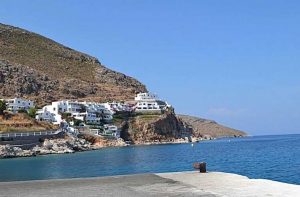
Tholos is another pretty cove, south east along the coast from Stavros. The trail starts from the cemetery and Agios Pandelimon basilica (which is worth popping into because it has an attractive Byzantine courtyard and mosaic floor). Or walk for about an hour west of Livadia to the ghost village of Mikro Horio which once had 1,200 inhabitants but was abandoned in the 1950s when the villagers migrated to the port. Now there’s only a church which hosts a festival in mid-August and a house which has been transformed into a late night music bar. See options about Tilos nightlife.
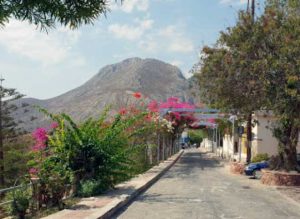
At Agios Antonios beach, to the west of Megalo Chorio, you can see the petrified remains of skeletons thought to belong to sailors caught in the volcanic eruption of nearby Nisyros in 600 BC. You can visit the still active volcano on Nisyros which is a 35-minute catamaran trip from Livadia. The crater floor is hot enough to melt rubber-soled shoes and gas vents let off steam at 98 degrees centigrade.
One of the island’s top attractions is the 15th century Monastery of Agios Pandelimon, perched 200 metres up on a cliff top on the west coast. The fortified monastery has a beautiful mosaic courtyard, some fine 18th century frescoes, circular chapels and the cells where the monks once lived. The monastery hosts a three-day festival from July 25th -28th.
What to eat
The food served on Tilos is traditional, good Greek food. Ask for mezedakia, small dishes, and try out some of the local specialities. Try the Dodecanese stuffed goat in oil paste, fouki (fried pork with onions, quenched in vinegar), but also fish but seafood: cuttlefish yachni, shrimp in batter, squash, boiled octopus.
Getting around
There are regular bus services to and from the port town of Livadia and the capital Megalo Horio. Buses also run frequently to popular Eristos Beach 2.5 kilometres south of the capital and you can take an excursion boat to the more remote beaches around the coastline.
But you may decide to hire a car or scooter for at least a day or two during your visit, especially if you’re not a keen hiker. You can rent a car or moped from Stefanakis Travel or Tilos Travel in the port. Prices vary according to the season, type of vehicle and duration of the rental agreement. The island’s only filling station is midway between Livadia and Megalo Horio.
If you’re thinking of hiring a scooter check that your travel insurance covers you for motorbike accidents before you take to the island’s rough tracks – because many policies don’t. And remember that wearing a helmet is compulsory in Greece if you’re riding anything over 49 cc although you wouldn’t think so to look at many of the local motorcyclists.
In any event, it’s a sensible precaution because there have been numerous cases of inexperienced foreigners ending up in hospital after coming a cropper on the hazardous roads of the Greek islands.
With the freedom of your own set of wheels you’ll be able to make the journey from the port to the capital along the eight-kilometre stretch of road that was widened and paved in 2000.
Megalo Horio is a pretty whitewashed settlement overlooked by the huge Castle of the Knights of St John which you can via a 40-minute walk along a trail that begins at the northern end of the village. Explore the village’s maze of narrow alleyways and take the time to visit the small Palaeontological Museum which houses the fossilised bones of mastodons (midget elephants) dating back to 7,000 BC. The bones were found in the Harkadhio Cave in the centre of the island in 1971.
Drive a short distance west of Megalo Horio and you’ll come to Agios Antonios Beach which has a decent taverna, frequented by local fishermen, and the petrified remains of lava-trapped human skeletons. You can see these eerie beach rocks at low tide – they’re thought to be the fossilised remains of sailors caught in the eruption of the nearby volcanic island of Nisyros in 600 BC.
The road continues west to the remote beach of Plaka in the north west corner of the island – good for swimming but there are not tourist facilities.
A short drive south down the west coast from Plaka takes you to the island’s main visitor attraction – the 15th century Monastery of Agiou Pandelimona, perched 200 metres up on a cliff top. The fortified monastery has a beautiful mosaic courtyard, some fine 18th century frescoes, circular chapels and the cells where the monks once lived.
Tilos Villages
Livadia
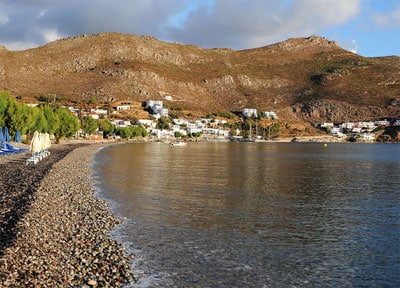
in Livadia you will find many hotels, rooms for rent, and restaurants that offer the opportunity to enjoy Cretan and Greek cuisine. In Livadia you will find banks, shops, pharmacies and services that cover the daily needs of visitors.
In the area there are many beautiful beaches, such as Livadiou Beach, Panormitissa, and Agios Andreas, where you can enjoy the sun and the sea.
In Livadia is also the central church of Tilos and a point of reference for locals and visitors. It is a beautiful destination for those looking for tranquility and natural beauty in the Aegean.
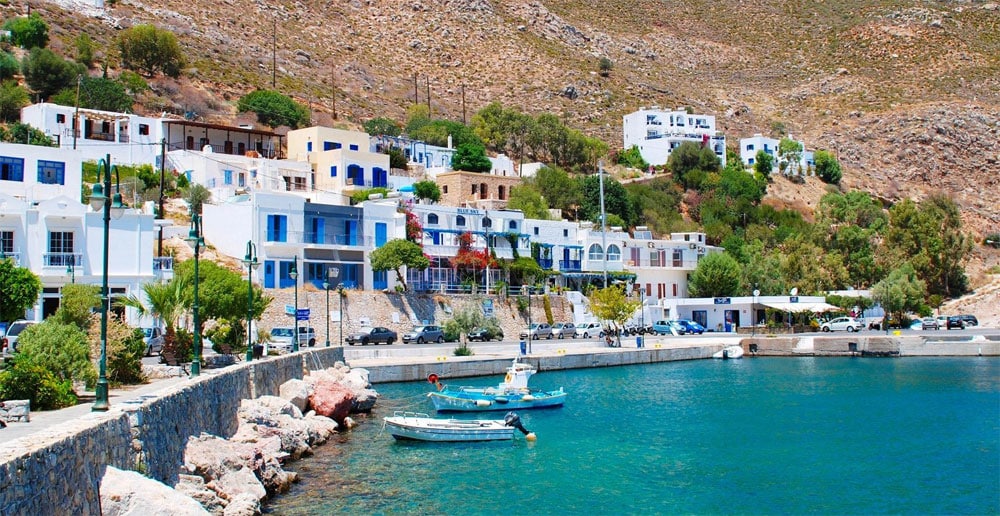
Megalo Chorio
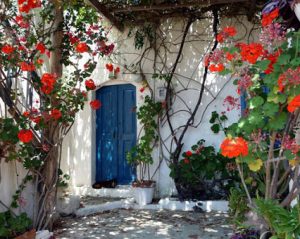
In the small collection housed under the town hall, on the main road of Megalo Chorio, are presented two skeletons of dwarf elephants and photographic material from the excavations in the cave Harkadio as well as skulls from the ancient cemetery of Agios Antonios.
Abandoned for decades, in the medieval village of Mikro Chorio you will walk among the ruins to the white church of Theotokissa. It “comes alive” in the summer nights, since in one of its old houses there is a bar, but also in the festival of the Virgin Mary.
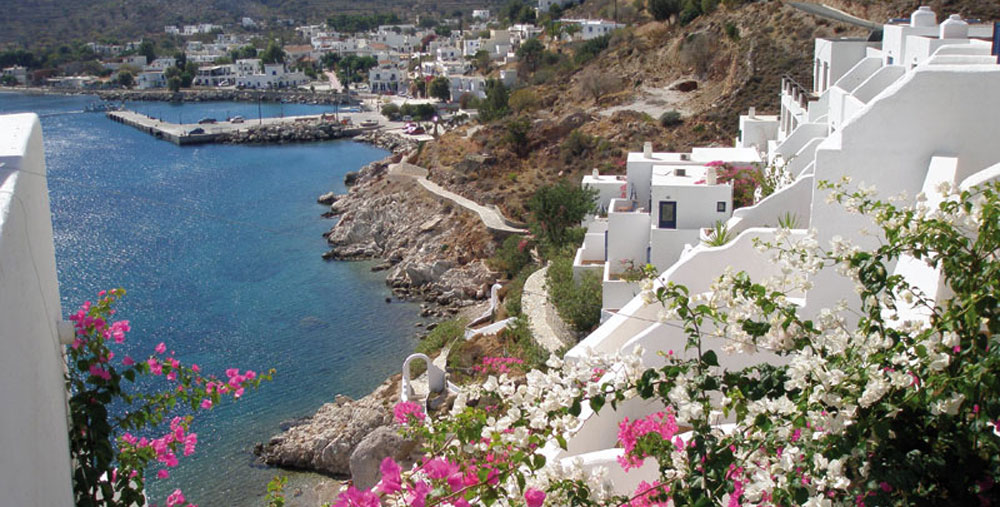
Where to stay
Livadia is the only place to stay in Tilos, there are no hotels scattered around the island. It is certainly not a bad thing given the small size and general tranquility that reigns on the island.
Tilos fills up late, also because the ferry timetables are generally confirmed after Easter, but the beds are not very many, and especially if you are looking for a sea view in the middle of August you need to move quickly to book your accommodation.
Getting to Tilos
Most people that travel to Tilos prefer to fly to Rhodes Greece and take a boat from there. Another alternative is to take a flight to Athens, and take a ferry boat from Piraeus. There are not daily ferry connections with these places, so be sure you leave in good time for your departure. If it gets windy the boats are cancelled.
Most travelers to Tilos first make their way to the larger nearby islands of Rhodes or Kos. These two islands have regular ferry connections with Tilos and are accessible by air or sea.
By Air
You can fly to Diagoras International Airport on Rhodes or Kos International Airport on Kos. Both islands have regular flights from Athens and other major European cities.
By Ferry
You can also take a ferry from the mainland of Greece to Rhodes or Kos. The port of Piraeus in Athens is the main departure point for ferries to these islands. The journey by ferry can take several hours to reach Rhodes or Kos, depending on the type of ferry.
Ferry from Rhodes to Tilos
From Rhodes, you can take a ferry to Tilos. The ferry journey from Rhodes to Tilos takes approximately 2-3 hours, but travel times can vary depending on the ferry company and the type of vessel. There are both conventional and high-speed ferries that operate this route.
Ferry from Kos to Tilos
If you’re on Kos, you can also take a ferry to Tilos. The ferry journey from Kos to Tilos takes around 2-3 hours, similar to the Rhodes to Tilos route. Ferries to Tilos usually depart from the main ports on these islands.
